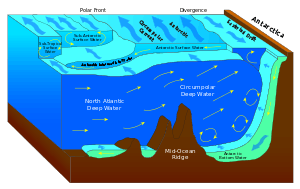Vine–Matthews–Morley hypothesis

The Vine–Matthews–Morley hypothesis, also known as the Morley–Vine–Matthews hypothesis, was the first key scientific test of the seafloor spreading theory of continental drift and plate tectonics.
History
Harry Hess proposed the sea-floor spreading hypothesis in 1960 (published in 1962). According to Hess, seafloor was created at mid-oceanic ridges by the convection of the earth's mantle, pushing and spreading the older crust away from the ridge.[1] Geophysicist Frederick John Vine and the Canadian geologist Lawrence W. Morley independently realized that if Hess’s seafloor spreading theory was correct, then the rocks surrounding the mid-oceanic ridges should show symmetric patterns of magnetization reversals using newly collected magnetic surveys. Morley's letters to Nature (February 1963) and Journal of Geophysical Research (April 1963) were both rejected, hence Vine and his PhD adviser at Cambridge University, Drummond Hoyle Matthews, were first to publish the theory in 1963.[2] Some colleagues were skeptical of the hypothesis because of the numerous assumptions made—seafloor spreading, geomagnetic reversals, and remnant magnetism—all hypotheses that were still not widely accepted.[3] The Vine-Matthews hypothesis describes the magnetic reversals of oceanic crust. Further proof of this hypothesis came from Cox et al. (1967) when he measured the remnant magnetization of lavas from land sites.[4] W.C. Pitman offered further evidence with a remarkably symmetric profile from the Pacific-Antarctic Ridge.
Geomagnetism
The Vine-Matthews hypothesis correlates the symmetric magnetic patterns seen on the seafloor with geomagnetic field reversals. At mid-ocean ridges, new crust is created by the injection, extrusion, and solidification of magma. After the magma has cooled through the Curie point, ferromagnetism becomes possible and the magnetic minerals in the newly formed crust orient themselves with the current background geomagnetic field.[5] Lithospheric creation at the ridge is considered continuous and symmetrical as the new crust pushes the old crust laterally and equally on either side of the ridge. Therefore, as geomagnetic reversal occur, the crust on either side of the ridge will contain a record of remnant magnetizations of normal or reversed magnetizations in comparison to the current geomagnetic field. The ridge crest is analogous to “twin-headed tape recorder”, recording the Earth’s magnetic history.[6] The intensity of the remnant magnetization is greater than the induced magnetization. The shape of the magnetic anomaly is controlled by the combination of the orientation of its total magnetization, the summation of the induced magnetization and remnant magnetization. Consequently, the shape of the magnetic is controlled predominately by the primary remnant vector. Blocks of crust at high latitudes have magnetic vectors that dip steeply downward in a normal magnetic field. However, close to the magnetic south pole, the magnetic vectors dip steeply downward in a reversed magnetic field and inclined steeply upwards in a normal magnetic field. There are positive magnetic anomalies over normally magnetized blocks and negative anomalies over reversed blocks.[7] Local anomalies with a short period also exist, but are considered to be correlated with bathymetry.[8] In low latitudes, the vectors are shallowly dipping and dipolar. This confuses the positive and negative anomalies. At the magnetic equator, the magnetic field is horizontal; negative anomalies are related to normally magnetized blocks and positive anomalies with reversed. The amplitude of the anomaly, magnetic field strength, and the magnitude of the remanence all decrease from the poles to the equator.[9] The orientation of the ridge affects the anomaly shape and amplitude. The component of the vector that effects the anomaly is at a maximum when the ridge is east-west and the magnetic profile is north-south. The anomalies are most apparent at high magnetic latitudes, north-south trending ridges at all latitudes, and east-west trending ridges at the magnetic equator.[10]
References
- ↑ Tetsuji Iseda. "Philosophical Interpretations of the Plate Tectonics Revolution". Retrieved 27 February 2011.
- ↑ "Frederick Vine and Drummond Matthews, Pioneers of Plate Tectonics". The Geological Society. Retrieved 19 Mar 2014.
- ↑ Frankel, Henry (1982). "The development, reception, and acceptance of the Vine-Matthews-Morley hypothesis.". Historical Studies in the Physical Sciences Baltimore, Md 13.1: 1–39. doi:10.2307/27757504.
- ↑ Kearey, Philip; Klepeis, Keith A.; Vine, Frederick J. "Global tectonics". John Wiley & Sons, 2009.
- ↑ Kearey, Philip; Klepeis, Keith A.; Vine, Frederick J. "Global tectonics". John Wiley & Sons, 2009.
- ↑ Vine, F.J. (1966). "Spreading of the ocean floor: new evidence.". Science 154 (3755): 1405–1415. doi:10.1126/science.154.3755.1405. PMID 17821553.
- ↑ Kearey, Philip; Klepeis, Keith A.; Vine, Frederick J. "Global tectonics". John Wiley & Sons, 2009.
- ↑ Vine, F. J; Matthews, D. H. (1963). "Magnetic Anomalies Over Oceanic Ridges (PDF)". Nature 199 (4897): 947–949. Bibcode:1963Natur.199..947V. doi:10.1038/199947a0.
- ↑ Kearey, Philip; Klepeis, Keith A.; Vine, Frederick J. "Global tectonics". John Wiley & Sons, 2009.
- ↑ Vine, F. J; Matthews, D. H. (1963). "Magnetic Anomalies Over Oceanic Ridges (PDF)". Nature 199 (4897): 947–949. Bibcode:1963Natur.199..947V. doi:10.1038/199947a0.
- Vine, F. J.; Matthews, D. H. (7 September 1963). "Magnetic Anomalies Over Oceanic Ridges (PDF)" (PDF). Nature 199 (4897): 947–949. Bibcode:1963Natur.199..947V. doi:10.1038/199947a0.
- Vine, F. J.; Wilson, J. Tuzo (October 1965). "Magnetic Anomalies over a Young Oceanic Ridge off Vancouver Island (PDF)" (PDF). Science 150 (3695): 485–9. Bibcode:1965Sci...150..485V. doi:10.1126/science.150.3695.485. PMID 17842754.
- Vine, F. J. (16 December 1966). "Spreading of the Ocean Floor: New Evidence (PDF)" (PDF). Science 154 (3755): 1405–1415. Bibcode:1966Sci...154.1405V. doi:10.1126/science.154.3755.1405. PMID 17821553.
| ||||||||||||||||||||||||||||

